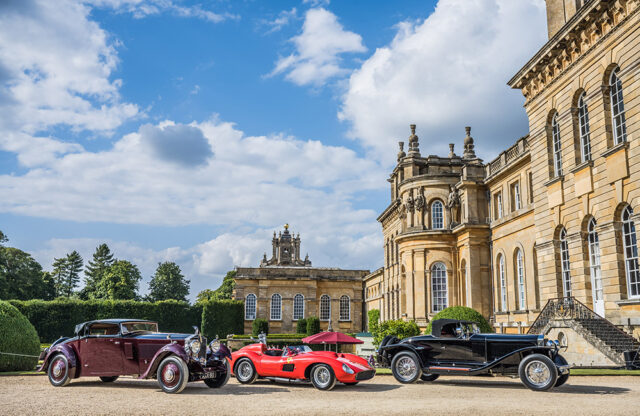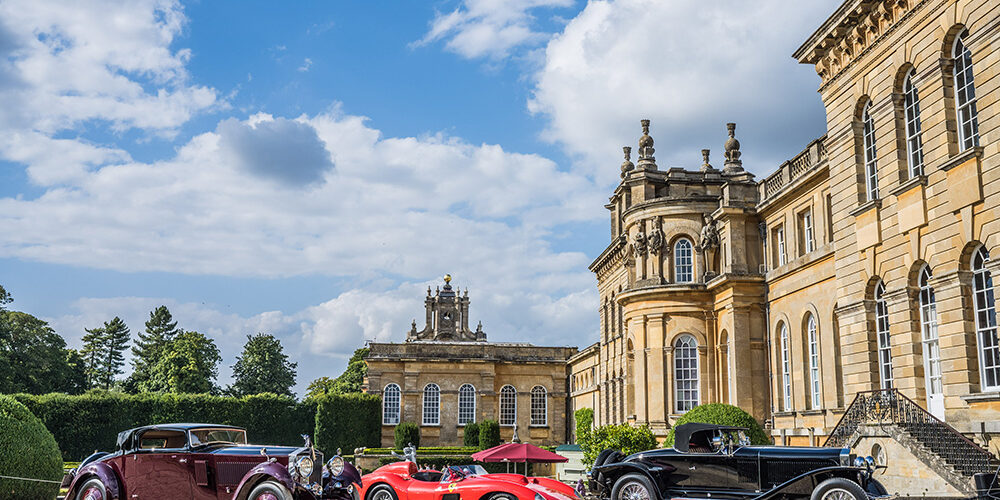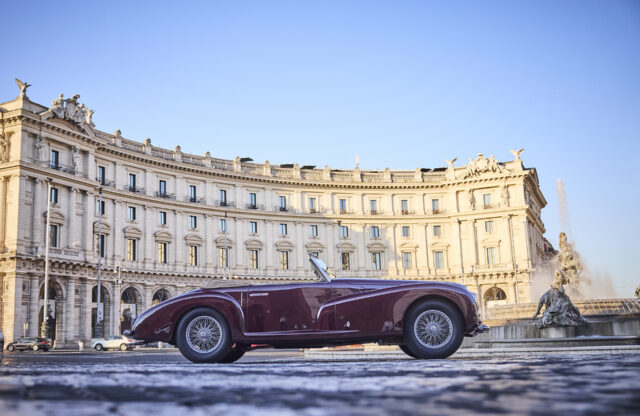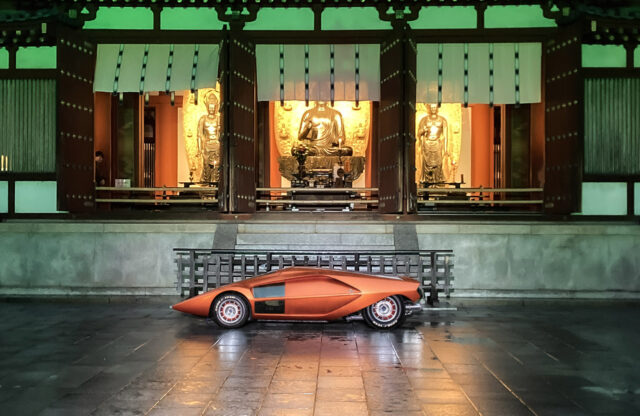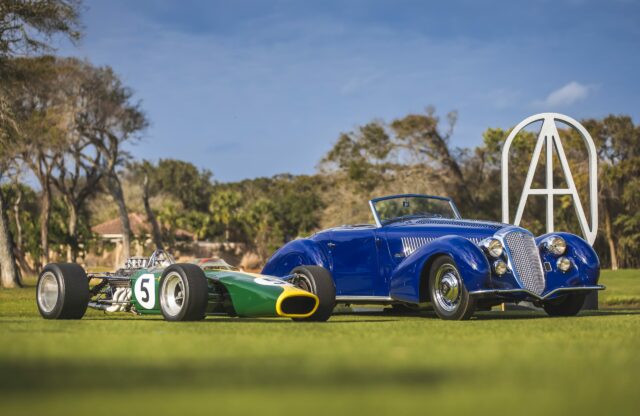The Salon Privé 2024 concours d’elegance brought a diverse selection of entrants to the charming grounds of Blenheim Palace, Oxfordshire, UK with a vast collection of cars sourced from around the world.
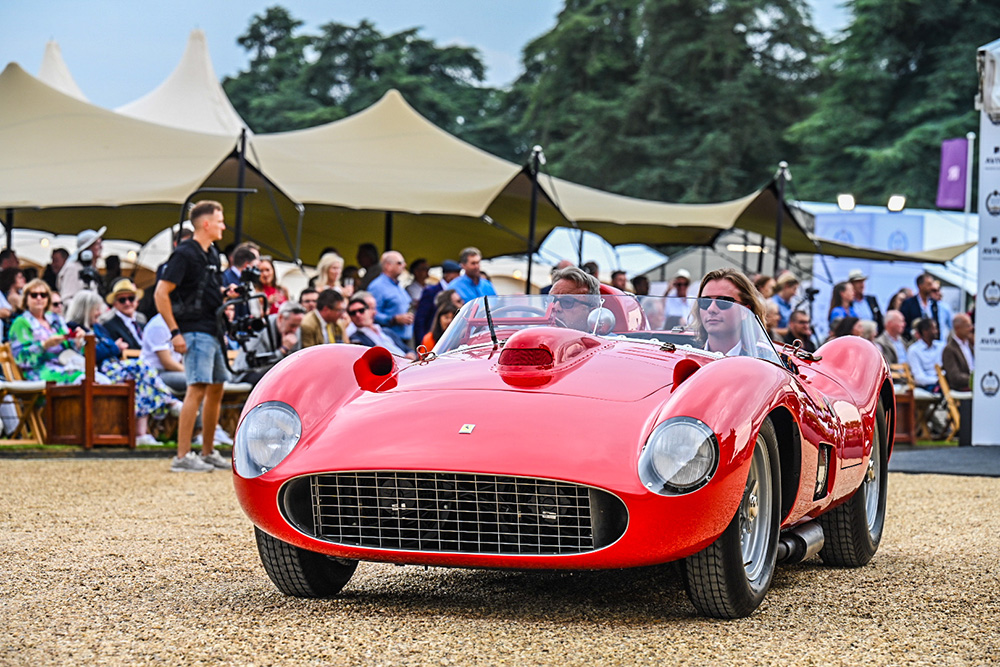
Something special that really marked out this year’s edition from what came before was the pre-cursor event, MotorAvia. The Salon Privé concours itself, which opened on Wednesday, August 28, saw 76 cars battle it out for concours glory, with 22 of them coming from overseas entrants. The winner was the 1957 Ferrari 315 S/335 Sport (above) owned by Brian Ross, which was campaigned by the likes of Peter Collins, Maurice Trintignant and Wolfgang von Trips at the Sebring 12 Hours and Mille Miglia in 315 S form, and by Mike Hawthorn and Luigi Musso in 335 Sport form at the Le Mans 24 Hours, Swedish Grand Prix and Caracas 1000km.
The Ferrari was then sold to Luigi Chinetti, who entered Stirling Moss into the 1958 Cuban GP – he was leading when the race was red-flagged after six laps. It was then leased to Mike Garber for Gaston Andrey to race in SCCA meetings, and saw victory at the Road America 500 (alongside Lance Reventlow) and at the Nassau races. It changed hands in 1959, and its whereabouts remained unknown until it was discovered by an architect some time in the 1960s. It subsequently joined the Bardinon Collection in 1969, remaining there until it joined the Ross Collection in 2016. Since then it’s been displayed at the Cavallino Classic, Amelia Island Concours and Pebble Beach Concours d’Elegance; earlier this year it won its class and took the President’s Trophy at the Concorso d’Eleganza Villa d’Este.

Second place went to Lord Bamford’s 1933 Rolls-Royce Phantom II Sport Saloon by Freestone & Webb (above), which was originally ordered new by cotton magnate Sir John Leigh. He later sold the Phantom II after ordering three Phantom IIIs in a day; the Phantom II would stay in the UK until the mid-1950s, when it was sold to Ohio. It remained there until 2013, when it came back to the UK via Lord Bamford, who returned it to its original two-tone paint scheme.
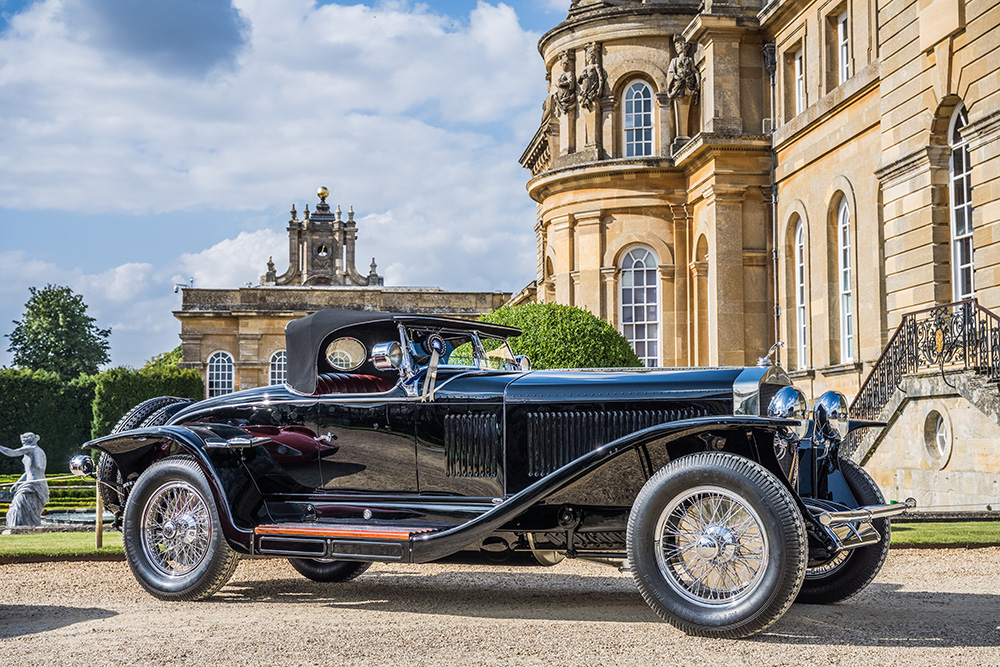
Third place went to Nick and Shelley Schorsch’s 1927 Isotta Fraschini Tipo 8AS Fleetwood Roadster (above). Although originally ordered by Hollywood star Rudolph Valentino, this LeBaron-designed, Fleetwood-built body would not be delivered in time for him to see it – he would pass away before it was completed it. It was then exhibited at the New York Auto Salon, and then displayed by Isotta Motors.
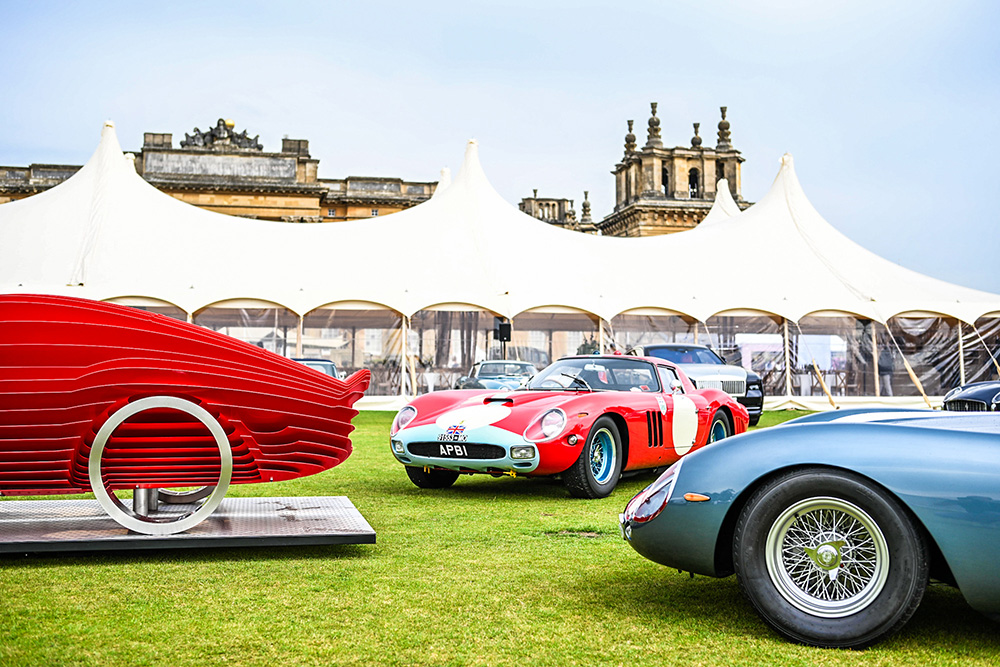
The atmosphere was an inclusive, joyful one: a lot of concours events bill themselves as a ‘garden party’, but Salon Privé actually feels like one – but with some exceptional cars to take in as well. Max Girardo was on fine form, sharing mic duties with organisers the Bagley brothers, and high-quality food and drink flowed. Despite some typically British showers, the event was jovial.
However, the Salon Privé concours was naturally all about the cars, and as such it boasted some innovative groupings. In light of the recent cancellation of the Geneva International Motor Show, the event brought together three cars that had made their debuts at the show in its 1950s and ’60s heyday: a 1961 Jaguar E-type, a 1960 Maserati 3500 GT Spyder by Touring and a 1951 Mercedes-Benz 300 S. Elsewhere, there was a class celebrating 120 years of Rolls-Royce, and 100 years since the launch of the Bugatti Type 35.
A great selection of extreme road cars from the 1990s certainly turned heads, as did a tribute to great motor sport liveries with Group C endurance racers providing an alluring entrance to the event. This depth of diversity is to the event’s great credit. Below, we’ve picked out some of our highlights from the concours. Which were your favourites?
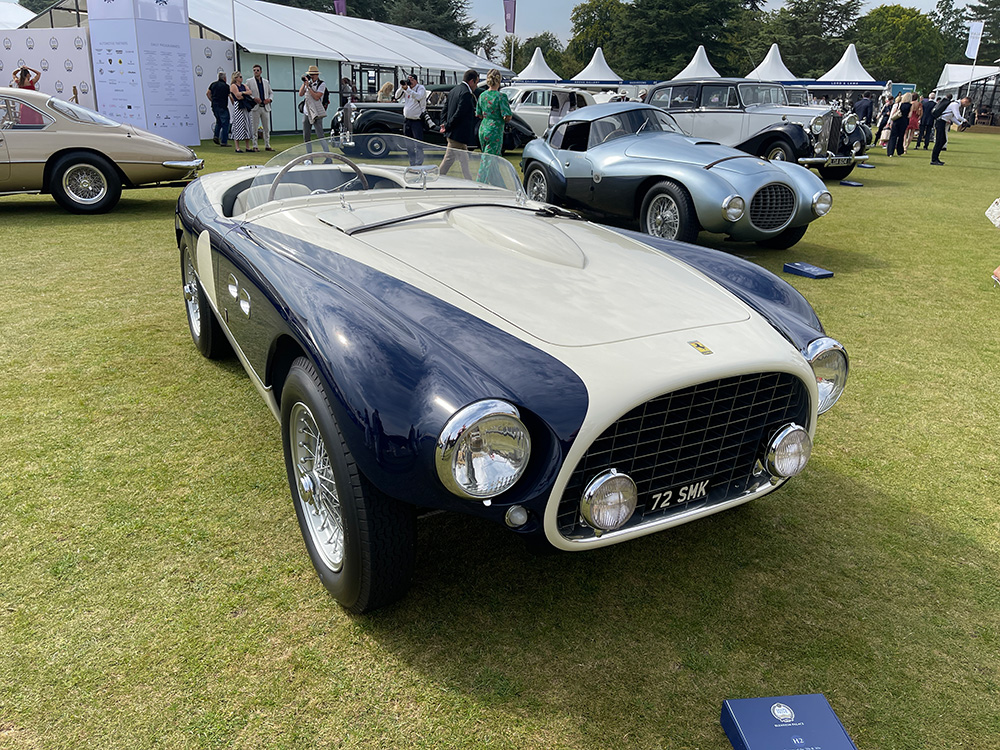
This 1953 Ferrari 166 MM/53 Spyder by Vignale was originally supplied to Porfirio Rubirosa, and driven by him and Pierre Leygonie at the Reims 12 Hours, which ended in retirement. It was then sold to Fernand Tavano via Luigi Chinetti, and registered in the name of Tavano’s cousin Virginio Guglielmini. Tavano would use the car to compete in several rallies and races in 1954 and 1955, before selling it to Garage Francorchamps in 1956.
It was driven by a variety of drivers, before being sold to Serge Orban in 1957. He would drive it in several hillclimbs before selling it to Pierre Berchem in October of that year. After one race at Monthléry, it was sold to the chief designer at Rolls-Royce Motors, Vivien Stanbury, via The Chequered Flag garage in London. Stanbury kept the car until 1960, when it was passed to Bernard R Worth of Gloucestershire. The Ferrari was acquired by Lord Bamford in 2023, and has since been restored by Clark & Carter.
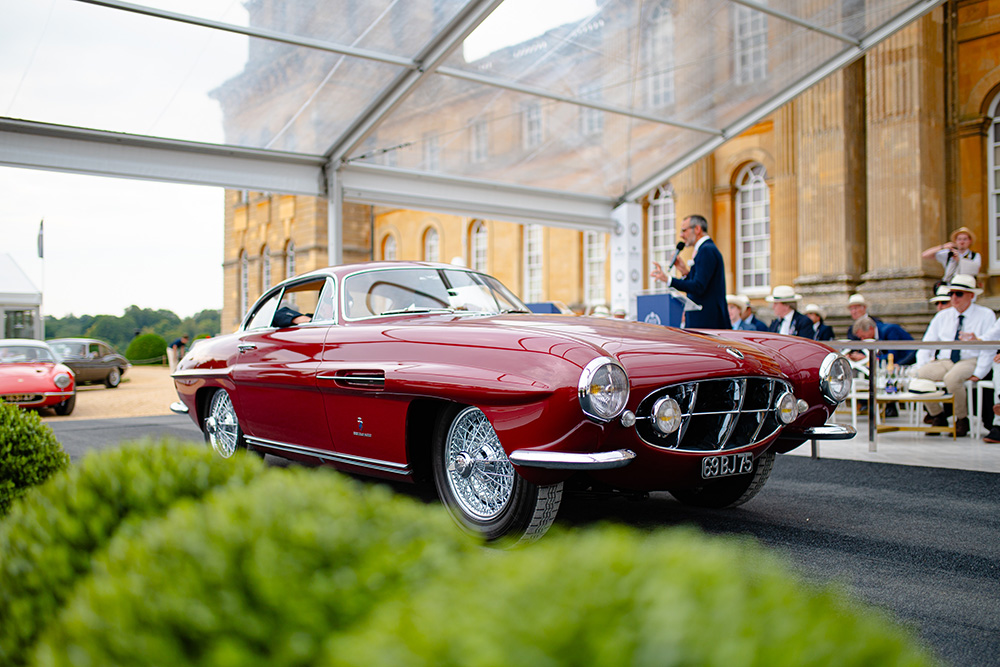
This 1952 Jaguar XK120 is one of three built – and one of two remaining – with Ghia Supersonic bodywork. First shown at the 1954 Paris and London Motor Shows, this Giovanni Savonuzzi-penned car is the only one of the three to be originally fitted with a Virgilio Conrero-tuned cylinder head. It also featured three two-barrel Weber carburettors, rather than the standard twin SU items, to deliver more than 220bhp.
It would later take part at the Montreux and Cannes concours d’elegance competitions. Originally built for a Mr Malpelli, the bill was unpaid with the dealer, Delecroix of Paris, and thus the car was returned and retained until 1969. It was then acquired by Philippe Renault, before forming part of the Roland Urban Jaguar collection at Montlhéry. It was then acquired by M Ferchaud in 1994, who restored the car with Atelier Sontrop in time for the 1998 Louis Vuitton Concours d’Elegance at Bagatelle.
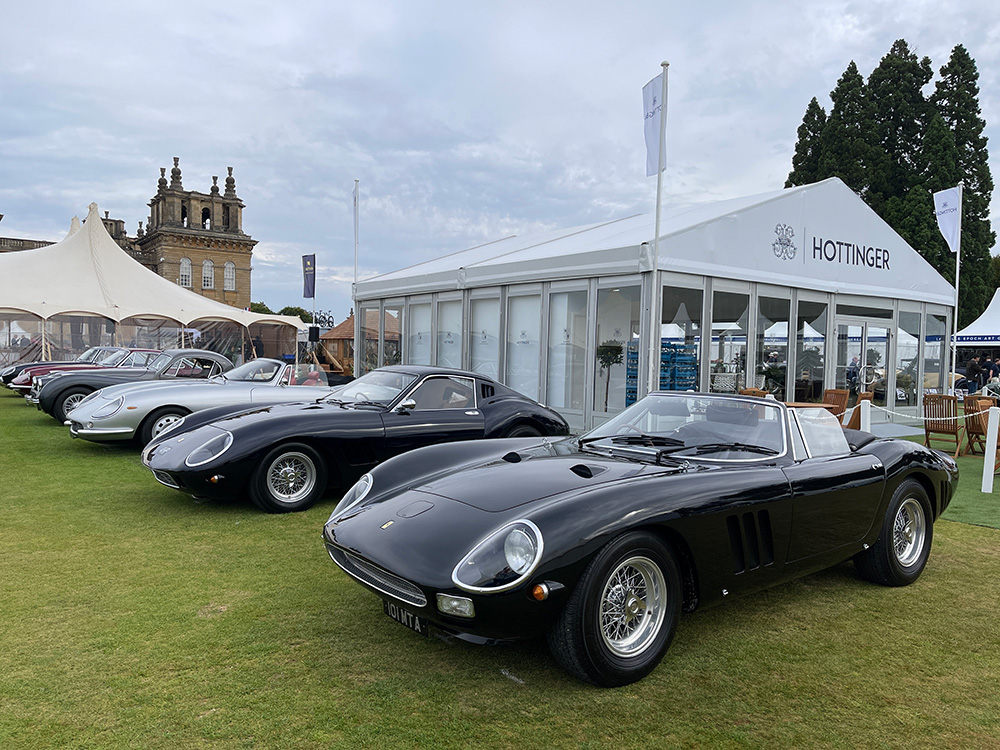
The Salon Privé concours was heavily supported by the Bamford family, with a wide selection of Ferraris on display, including a 250 GTO. Two of the most fascinating cars were the two Ferrari 400i-derived models, in the central paddock. Penned by freelance industrial designer Chris Hampson and Chris Major (who worked for JCB as design manager) for Anthony Bamford, the 400 GTO (second in) was intended as a ‘cheap’ car for Bamford to take on holiday to the South of France, and it was built in 1995.
In 2000, the model in the foreground was built on the same basis, this time imagining what a 250 GTO Convertible might be like. Both were built by Brian Wingfield of DRL Engineering. Meanwhile, the silver car is one of two Ferrari 456s converted to look like a 275 NART Spyder via Lord Anthony’s son, George.
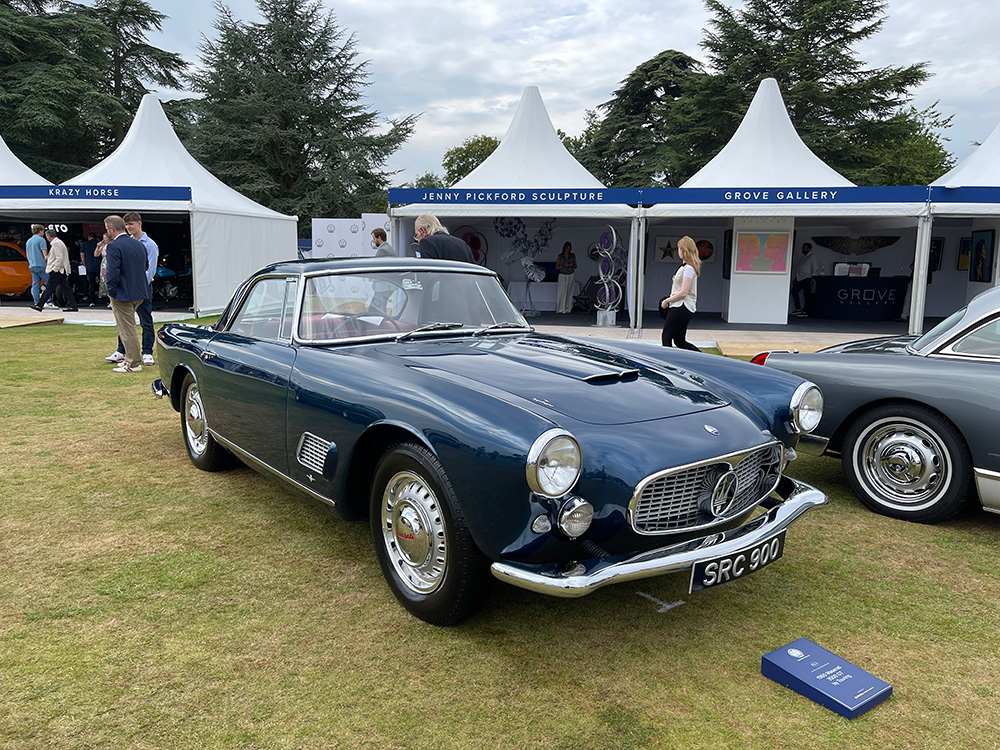
This Maserati 3500 GT is the oldest known right-hand-drive example of the breed, and was originally finished in grey with a red interior. It spent much of its early life around Nottingham and Derby, before heading to Suffolk in 1965 with the Curtis family. It would remain with them for the next four decades, being used sparingly – although it did appear in the 1997 book Maserati Heritage. Sold at auction in 2015, and again in 2020, it retains its original interior, and it is now fresh from restoration with Barkaways.

Niki Lauda drove this BRM P160E in the 1973 Formula 1 World Championship, after taking out a bank loan following a disastrous stint at March in 1972. The car would prove to be fast but unreliable, with nine retirements. However, Lauda managed to get it into fifth place at the Belgian Grand Prix, and although the race would end in retirement after six laps, his impressive efforts at the Monaco GP (he qualified sixth, ahead of Clay Regazzoni in the sister BRM and Jacky Ickx in the Ferrari) were enough to convince Enzo Ferrari to give him a race seat for the 1974 season.

The Ferrari F50 is currently a hot topic – one recently sold for $5.5m in Monterey – and two examples came to the Salon Privé concours. The car in the foreground is one of eight finished in Rosso Barchetta, a tribute to hues from 1950s Ferraris. Another highlight car in this class was an ex-Gerhard Berger 1991 Ferrari Testarossa. During the F1 driver’s time with the car, he regularly took it to 180mph on public roads, although the ownership experience wasn’t always an easy one – on one long drive he started to smell fire, so he had to complete the rest of his journey turning the car’s headlamps off and on.

This 1965 Rolls-Royce Phantom V by Mulliner Park Ward was the second Phantom V owned by John Lennon. The first was the infamous Romany gypsy wagon-inspired car that was painted by JP Fallon’s Steve Weaver, which was later donated to the Cooper-Hewitt Museum to cover a tax bill (it now resides in the Royal British Columbia Museum in Canada). The Phantom V at Salon Privé was bought by The Beatles star in 1968, to match the White Album.
Sourced by Les Anthony, Lennon’s chauffeur, via a teenage apprentice at Golden Wheels Garages in Sloane Avenue, Chelsea, the Rolls-Royce was originally a two-tone black-over-green example. When the car was delivered to Lennon, the Beatle wanted it changed to white inside and out, which would end up costing £12,000. Other bespoke features included a white steering wheel, a telephone and a unique roof aerial. Lennon wasn’t the only member of British rock royalty to use it – it would later appear in the Mick Jagger film Performance.
In 1969 the Phantom was sold to Allen Klein, a record-label executive, and its whereabouts remained unknown until 2016, when it popped up at the Rolls-Royce Enthusiasts’ Club annual rally at Burghley House, near Stamford, UK. After Klein’s passing, it had been restored back to original condition by Jody Klein, his son. The car won the Chairman’s Award.

This Ferrari – more commonly known as the Uovo – began life as a 1960 166 MM, and originally delivered to the Marzotto brothers. Their racing passions were fuelled by the family textile business, which led to one of the siblings, Umberto, acquiring this car in 1950. It was first entered into the Targa Florio, but retired with clutch problems. Its next outing was the Mille Miglia, with Umberto teaming up with co-driver Franco Cristaldi.
However, a heavy crash ruled them out, and the car was sent to Ferrari to be rebuilt. Giannino Marzotto believed a more aerodynamic approach might provide the edge in racing, and contracted Fontana of Padova, and sculptor Franco Reggiani, to create a streamlined body. The bare Ferrari frame was placed over a tubular structure, which was reversed and bonded with Peraluman plates with the aim of creating light but rigid outer shell. Light it was – by around 150kg compared to contemporary Ferraris, which helped provide a range of 550km. It was also fitted with twin dampers and a regulator for its Formula 2-derived brakes.
The car proved to be fast but frail – at the Giro di Sicilia, painted in bare aluminium, it was leading by 20km before a broken O-ring in the differential scuppered it chances, and at the Mille Miglia a 30km lead over the Works Ferrari ended in retirement due to tyre problems. It all came good on the Giro della Toscana, with Giannino and Marco Crosara taking victory. The Uovo would be entered into the Mille Miglia with Guido Mancini and Adriano Ercolani in 1952, but it would retire after running in the top ten. However, it would notch up victories at the Trento-Bordone hillclimb and a class win at the Coppa della Toscana later that year.
After finishing fourth at the Avus Grand Prix in September 1952, the Ferrari would be returned to its maker to be overhauled for the 1953 Mille Miglia, but the Marzottos chose to compete with a 340 MM Spyder instead. The Uovo was shipped to Mexico to compete in the Carrera Panamericana, but wouldn’t race. The car would remain in Mexico, before being sold to North America via Carlos Braniff, to Ignacio Lozano, the publisher of La Opinion, an LA-based Spanish-language newspaper. He would compete with the car through 1954, before selling it to Pete Lovely. After passing through several US collections, it was brought to England and restored in time for the 1986 Mille Miglia.

This 1967 Fiat 6C 1500 is a unique creation designed by Mario Revelli di Beaumont for Ghia. It was commissioned by General Italo Balbo, the governor of Libya and a famous aviator. It was ordered in right-hand drive, and is believed to have been intended for the Italian embassy in London, where it was first registered in March 1937. It had been kept outside for 40 years before being rescued and put into storage 12 years ago. In 2021 it was acquired by the current owners.
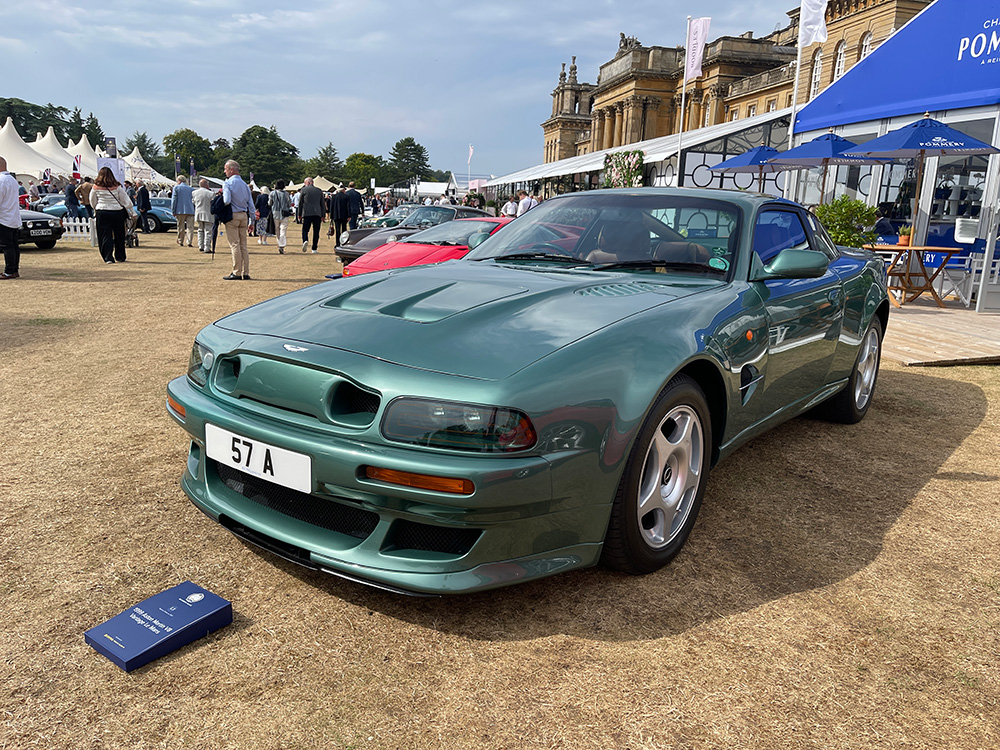
This Aston Martin V8 Vantage V600 LM was originally used at the 40th anniversary celebrations of Aston Martin’s Le Mans win in 1999, driven by Keith Riddington, then of Aston Martin Works and now of Classicmobilia. During a demonstration lap the car was shown off to its full potential between the Dunlop Bridge and through Tertre Rouge with a cornering speed of 150mph. After the V8 Vantage got up to 170mph on the Mulsanne Straight, a coolant hose broke, causing the circuit to be closed for a while…

This AC-Ace Bristol was raced by Bob Burnard in period, taking him to victory in the BARC Veedol Championship with victory in the Tourist Trophy at Goodwood in 1962. His prize was a Lotus 27 Formula Junior car, which was presented to him by the Veedol oil company’s chairman, Paul Getty. That Lotus 27 was parked alongside the AC-Ace and is pictured below – it is believed this is the first time the two cars have been parked next to each other since the 1960s. The Formula Junior season wasn’t a success – Bob was a distinctly un-single-seater-shaped 6ft 2in.

Salon Privé had a fine selection of food available to guests, and plenty of lifestyle temptations, with everything from jets and boats to watches and menswear. New-car manufacturer support was good, too, with the likes of Lamborghini, Aston Martin Porsche, Rolls-Royce, Maserati, Bentley, Koenigsegg UK, Morgan and MG in attendance. Independent bespoke firms such as Tuthill, Theon, Oshe, Zenvo, Clive Sutton, Electrogenic, Brabus and more were also present.
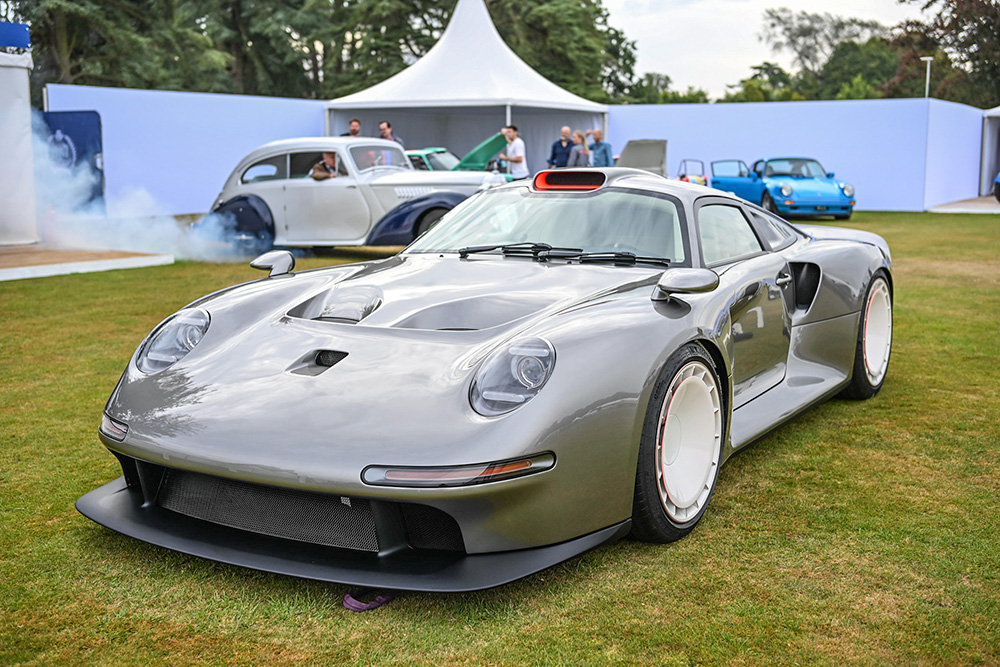
The concours also saw the UK launch of the Tuthill GT-One. After a show-stopping reveal during Monterey Car Week (which you can read more about here), Tuthill confirmed that the allocation of 22 cars have all been assigned. Although a delivery date is yet to be announced – Tuthill says there is testing and homologation to conclude – it took little more than a week for all the slots to be filled.

Maserati chose the Salon Privé concours to showcase the Maserati GranCabrio on UK soil for the first time. While the GranTurismo is available in different levels of tune, the GranCabrio is currently available only in full-fat Trofeo form, which means 550bhp, 650Nm of torque and a breezy 196mph top speed.
For more on the Salon Privé concours, head here.
FULL LIST OF WINNERS
2024 Salon Privé presented by Aviva Private Clients
Best of Show: 1957 Ferrari 335 S by Scaglietti (Brian Ross)
Chairman’s Award: 1923 Rolls-Royce Springfield Silver Ghost Pall Mall (Jack Boyd Smith Jr)
Duke of Marlborough Award: 1993 Lamborghini Diablo (Lars Nielsen)
Most Iconic – The George Barry Gregory Trophy: 1965 Rolls-Royce Phantom V by Mulliner Park Ward (Jody Klein)
Class A: Pre-War Open: 1927 Isotta Fraschini Tipo 8AS Fleetwood Roadster (Nic and Shelley Schorsch)
Class B: Bugatti – Grand Prix to Grand Touring: 1939 Bugatti Type 57 Cabriolet by Saoutchik (Anne Brockinton-Lee)
Class C: Pre-War Closed/Elegance: 1938 Bentley 4¼ L Brougham de Ville by James Young (Axel Schroeter)
Class D1: Inspiring Greatness – 120 Years of Rolls-Royce (Pre-War): 1933 Rolls-Royce Phantom II Sport Saloon by Freestone & Webb (Lord Bamford)
Class D2: Inspiring Greatness – 120 Years of Rolls-Royce (Post-War): 1954 Rolls-Royce Silver Dawn DHC by Park Ward (Volker Schumann)
Class E: Post-War Open: 1951 Mercedes-Benz 300 S Cabriolet A (Albert Streminski)
Class F1: Post-War Closed (International): 1960 Maserati 3500 GT by Touring (Greg Newman)
Class F2: Post-War Closed (British): 1952 Jaguar XK 120 Supersonic by Ghia (Bill Heinecke)
Class G: Sports-Racers: 1957 Ferrari 335 S by Scaglietti (Brian Ross)
Class H: Ferraris of the 1950s and ’60s: 1953 Ferrari 166 MM Spyder by Vignale (Lord Bamford)
Class I: 60th Anniversary of the Ferrari 275: 1965 Ferrari 275 GTB/C by Scaglietti (Private collector)
Class J: Legendary Liveries: 1996 Subaru Impreza WRC97 by Prodrive (Richard Coar)
Class K: Supercar Icons – Prancing Horse: 1996 Ferrari F50 by Pininfarina (Karim Said)
Class L: Supercar Icons to 2005: 2004 Porsche 996.2 GT2 (Rob Howarth)
Honorary Awards
Spirit Award – The Margaret Bagley Trophy: 1960 Maserati 3500 GT Spyder by Vignale (Claudio Mosconi)
Most Exceptional Coachwork: 1966 Ferrari 500 Superfast by Pininfarina (Andrew Bagnell)
Most Opulent: 1969 Rolls-Royce Phantom VI Park Ward (Murad Salikhov)
Coup de Coeur – The Matt Pearce Trophy: 1958 AC Ace (Mike Dacre)
Best Interior: 1939 Rolls-Royce Wraith by Mann Egerton (Edward Iliffe)
Most Elegant: 1932 Bugatti Type 55 by Gangloff (Shane Houlihan)
Best Works Car: 1956 Lister-Maserati (Christian Jenny)
Best Liveried Race Car: 1967 MGC GTS Lightweight (Martin Block)
Best Open Car: 1965 Ferrari 275 GTS by Pininfarina (Joe Macari)
People’s Choice: 1996 Ferrari F50 by Pininfarina (Paul Hogarth)
